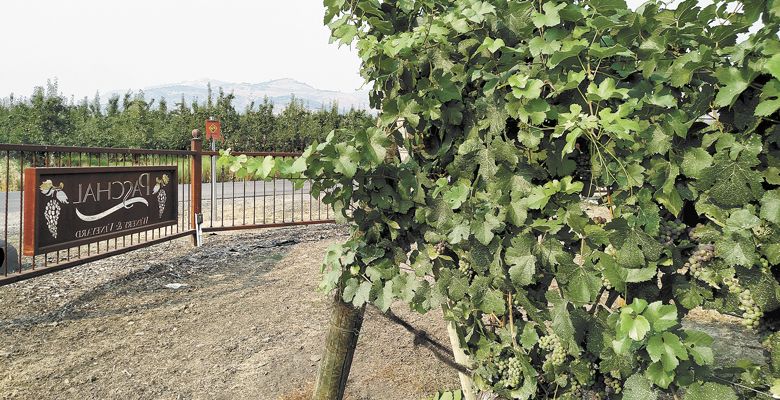Blazing Ahead
Southern Oregon wineries on high smoke alert
Summer wildfires are nothing new on the West Coast. Over the last 20 years, fires have periodically pushed low, dense clouds of smoke into winegrowing areas.
Since 1988, Eric Weisinger and his father have been making wine with Southern Oregon grapes. He recalls some particularly smoky years. “Winemaking is the art of intelligent compromise,” Eric explains. “If you’re not in control (as is the case with smoke exposure), you’re going to have to compromise, and the art is to do it as intelligently as possible.”
While fire and the resultant haze present just one more environmental variable for grapegrowers and winemakers, large scale fires have increased. The wine industry now pays closer attention to the effect of smoke on grapes in establishing protocols for how best to account for exposure in the production process. Thanks to the dedicated work of viticulturists and enologists around the world and here in Oregon, some of the unknowns surrounding exposure to smoke are coming into focus.
Exposure to smoke will have some effect on the grapes, but, explains Kiley Evans, winemaker at Medford’s 2Hawk Vineyard & Winery, not all smoke is created equal. “Certain kinds of smoke are more impactful, and the intensity of the smoke and duration of the exposure all can make a difference.”
Varietal and timing of exposure, handling at harvest and the winemaking process can all affect how notes of smoke are expressed in wine. Whites are less affected by smoke than reds, which are fermented and pressed with the skins.
Not everyone detects a wine’s smoke or oak notes the same way, and some consumers can’t detect low levels at all. In some wines, that smoky, oaky retro-nasal aroma occurs naturally, an aspect of a wine’s desired profile or representative of a winemaker’s signature.
Oregon State University’s Dr. Elizabeth Tomasino’s specialty deals with exactly that: the sensory evaluation of wine. “Smell is one reason why everyone tastes wine differently, and your sense of smell goes back to genetics,” Tomasino explains. “So people will have different sensitivities to smoke taint based on their differing abilities. After all, smoke is not a taste; it’s a smell due to the aroma compounds.”
Testing for smoke taint, still in the early stages, establishes benchmarks to determine free volatile phenols and glycosylate markers that identify some smoke effect compounds. Latent phenolic compounds are expressed as the wine ages, so even if grapes test within acceptable limits at harvest, a smoke effect may develop as the wine ages. The chemistry of aging and the predictive relationship between early results and later findings are not fully understood.
Evans says he spent the entire outside lab budget during the first two weeks of the 2017 harvest; he found all lots within acceptable ranges. In doing so, he established an important and controlled reference data to use as the 2017 vintage wines are bottled, aged, tasted and tested.
At Naumes Crush & Fermentation in Medford, winemaker Chris Graves finds winegrape buyers are more likely now to have smoke taint clauses written into their contracts, a clause that might read as follows: “Buyer reserves the right to sample the fruit for smoke taint. If the test results are above 2 parts per billion, the buyer has the right to reject the fruit.” The acceptable smoke taint level is negotiated between the parties and the buyer usually bears the cost of testing, approximately $100 per block.
In 2017, all of Graves’ clients’ lab tests for smoke taint came back within acceptable limits except for one Applegate vineyard. Weisinger’s tests on estate grapes grown in five locations around Ashland also returned within an acceptable range.
When heavy smoke has the potential to affect the grapes, a winemaker’s skill and experience come into play and their options are to enhance, mitigate or mask smoke taint. Oregon’s 2018 harvest is practically upon us, and winemakers are ready to start testing grapes and sharing lab results with one another.
There may be some hard decisions in this year’s harvest, and some will be gut-instinct calls. The best winemakers are good at that, intuitively understanding both the art and craft of winemaking.
“Hand-harvest your fruit if you can; be very gentle,” advises Graves. “You need to be very clean in the harvesting and leave out any leaf material.” Graves might treat the press fraction differently and not blend it with the primary press. He says he may also use oak chips or a higher level of new oak to intentionally enhance that smoky note as a stylistic approach.
As a precaution this year, Evans plans to press all of 2Hawk’s reds lightly using a basket press yielding 120 to 125 gallons per ton, rather than using the typical membrane press at 150 to 165 gallons per ton. “The harder you press, the more concentrated the smoke taint compounds become,” he explains. “Hopefully, I won’t have to change my protocols and this will only be a good insurance measure.
“You’re not going to be able to define all problems scientifically,” continues Evans. “We’re going to know about 60 to 70 percent of what we need to know, take some risks and be judicious in our protocols so that we have varietal character and vintage character, too.”











